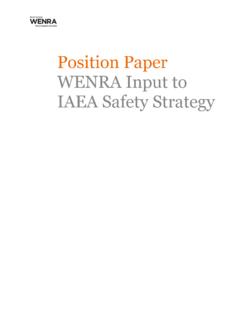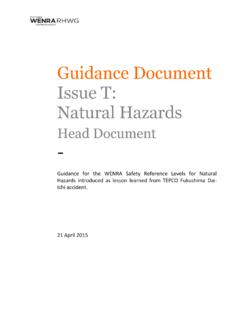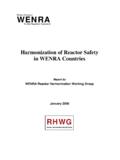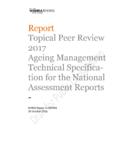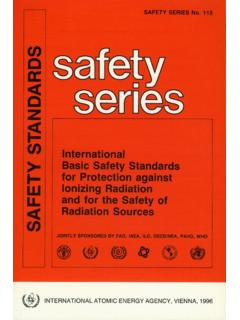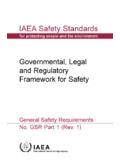Transcription of Report WENRA Safety Reference Levels for …
1 Report WENRA . Safety Reference Levels for existing Reactors - UPDATE IN RELATION TO LESSONS LEARNED FROM TEPCO. FUKUSHIMA DAI-ICHI ACCIDENT. 24th September 2014. Table of Content WENRA . Safety Reference Levels for existing Reactors - Foreword 3. 01 Issue A: Safety Policy 4. 02 Issue B: Operating Organisation 6. 03 Issue C: Management System 8. 04 Issue D: Training and Authorization of NPP Staff (Jobs with Safety Im- 11. portance). 05 Issue E: Design Basis Envelope for existing Reactors 13. 06 Issue F: Design Extension of existing Reactors 20. 07 Issue G: Safety Classification of Structures, Systems and Components 24. 08 Issue H: Operational Limits and Conditions (OLCs) 25. 09 Issue I: Ageing Management 27. 10 Issue J: System for Investigation of Events and Operational Experience 28. Feedback 11 Issue K: Maintenance, In-Service Inspection and Functional Testing 30. 12 Issue LM: Emergency Operating Procedures and Severe Accident Manage- 33.
2 Ment Guidelines 13 Issue N: Contents and Updating of Safety Analysis Report (SAR) 36. 14 Issue O: Probabilistic Safety Analysis (PSA) 38. 15 Issue P: Periodic Safety Review (PSR) 40. 16 Issue Q: Plant Modifications 42. 17 Issue R: On-site Emergency Preparedness 44. 18 Issue S: Protection against Internal Fires 47. 19 Issue T: Natural Hazards 50. WENRA Safety Reference Level for existing Reactors_September 24th September 2014 / Page 2. Foreword - A principal aim of the Western European Nuclear Regulators' Association ( WENRA ) is to de- velop a harmonized approach to nuclear Safety within the member countries. One of the first major achievements to this end was the publication in 2006 of a set of Safety Reference Levels (RLs) for operating nuclear power plants (NPPs). The RLs are agreed by the WENRA members. They reflect expected practices to be imple- mented in the WENRA countries. As the WENRA members have different responsibilities, the emphasis of the RLs has been on nuclear Safety , primarily focussing on Safety of the reactor core and spent fuel.
3 The RLs specifically exclude nuclear security and, with a few exceptions, radiation Safety . As RLs have been established for greater harmonization within WENRA countries, the areas and issues they address were selected to cover important aspects of nuclear Safety where differences in substance between WENRA countries might be expected. They do not seek to cover everything that could have an impact upon nuclear Safety or to form a basis for deter- mining the overall level of nuclear Safety in operating NPPs. Given the various regulatory regimes and range of types of plants (PWR, BWR, CANDU and gas-cooled reactors) in operation in WENRA countries, the RLs do not go into legal and tech- nical details. When needed, a Reference to a relevant IAEA publication is inserted. There are significant interactions between some of the issues and hence each issue should not necessarily be considered self-standing and the RLs need to be considered as a whole set.
4 WENRA is committed to continuous improvement of nuclear Safety . To this end WENRA is committed to regularly revising the RLs when new knowledge and experience are available. In line with this policy the initial RLs were updated in 2007 and 2008. After the TEPCO Fukushi- ma Dai-ichi nuclear accident, they have been further updated to take into account the lessons learned, including the insight from the EU stress tests. As a result a new issue on natural haz- ards was developed and significant changes made to several existing issues. By issuing the revised RLs WENRA aims at further convergence of national requirements and Safety improvements at NPPs in WENRA member countries, as necessary. Stakeholders were asked for comments on the revised Reference Levels . All the comments were reviewed during the finalization process. For further information, several documents on the WENRA website describe the basis used and processes followed to develop and update these RLs.
5 Guidance on specific issues is also available on the WENRA website For the explanation of the current update the accompanying Report Updating WENRA Refer- ence Levels for existing reactors in the light of TEPCO Fukushima Dai-ichi accident lessons learned was written and can also be downloaded from the WENRA website. WENRA Safety Reference Level for existing Reactors_September 24th September 2014 / Page 3. 01. Issue A: Safety Policy Safety area: Safety Management - A1. Issuing and communication of a Safety A written Safety policy1 shall be issued by the licensee. The Safety policy shall be clear about giving Safety an overriding priority in all plant activities. The Safety policy shall include a commitment to continuously develop Safety . The Safety policy shall be communicated to all site personnel with tasks important to Safety , in such a way that the policy is understood and applied. Key elements of the Safety policy shall be communicated to contractors, in such a way that licensee's expectations and requirements are understood and applied in their ac- tivities.
6 A2. Implementation of the Safety policy and monitoring Safety performance The Safety policy shall require directives for implementing the policy and monitoring Safety performance. The Safety policy shall require Safety objectives and targets, clearly formulated in such a way that they can be easily monitored and followed up by the plant management. The Safety policy shall require continuous improvement of nuclear Safety by means of: Identifying and analysing any new information with a timeframe commensurate to its Safety significance;. Regular2 review of the overall Safety of the nuclear power plant including the Safety demonstration, taking into account operating experience, Safety research, and advances in science and technology;. Timely implementation of the reasonably practicable Safety improvements identi- fied. Continuous improvement applies to all nuclear Safety activities and hence it is rele- vant to all of the issues addressed in this document.
7 Therefore, this requirement is not repeated in the other issues although it is applicable to all of them. 1. A Safety policy is understood as a documented commitment by the licensee to a high nuclear Safety perfor- mance supported by clear Safety objectives and targets and a commitment of necessary resources to achieve these targets. The Safety policy is issued as separate Safety management document or as a visible part of an in- tegrated organisational policy. 2. Regular is understood as an ongoing activity to review and analyse the plant design and operation and identify opportunities for improvement. Periodic Safety review is a complementary tool to verify and follow up this ac- tivity in a longer perspective. WENRA Safety Reference Level for existing Reactors_September 24th September 2014 / Page 4. A3. Evaluation of the Safety policy The adequacy and the implementation status of the Safety policy shall be evaluated by the licensee on a regular basis, more frequent than the periodic Safety reviews.
8 WENRA Safety Reference Level for existing Reactors_September 24th September 2014 / Page 5. 02. Issue B: Operating Organisation Safety area: Safety Management - B1. Organisational structure The organisational structure for safe and reliable operation of the plant, and for en- suring an appropriate response in emergencies, shall be justified3 and documented. The adequacy of the organisational structure, for its purposes according to , shall be assessed when organisational changes are made which might be significant for Safety . Such changes shall be justified in advance, carefully planned, and evaluated4. after implementation. Responsibilities, authorities, and lines of communication shall be clearly defined and documented for all staff with duties important to Safety . B2. Management of Safety and quality The licensee shall ensure that the plant is operated in a safe manner and in accord- ance with all applicable legal and regulatory requirements.
9 The licensee shall ensure that decisions on Safety matters are timely and preceded by appropriate investigation and consultation so that all relevant Safety aspects are con- sidered. Safety issues shall be subjected to appropriate Safety review, by a suitably qualified independent review function. The licensee shall ensure that the staff is provided with the necessary facilities and working conditions to carry out work in a safe manner. The licensee shall ensure that Safety performance is continuously monitored through an appropriate review system in order to ensure that Safety is maintained and im- proved as needed. The licensee shall ensure that relevant operating experience, international develop- ment of Safety standards and new knowledge gained through R&D-projects are ana- lysed in a systematic way and continuously used to improve the plant and the licen- see's activities. The licensee shall ensure that plant activities and processes are controlled through a documented management system covering all activities, including relevant activities of vendors and contractors, which may affect the safe operation of the plant.
10 3. The arguments shall be provided that the organisational structure supports Safety and an appropriate re- sponse in emergencies. 4. A verification that the implementation of the organisational change has accomplished its Safety objectives. WENRA Safety Reference Level for existing Reactors_September 24th September 2014 / Page 6. B3. Sufficiency and competency of staff The required number of staff for safe operation5, and their competence, shall be ana- lysed in a systematic and documented way. The sufficiency of staff for safe operation, their competence, and suitability for Safety work shall be verified on a regular basis and documented. A long-term staffing plan6 shall exist for activities that are important to Safety . Changes to the number of staff, which might be significant for Safety , shall be justified in advance, carefully planned and evaluated after implementation. The licensee shall always have in house, sufficient, and competent staff and resources to understand the licensing basis of the plant ( Safety Analysis Report or Safety Case and other documents based thereon), as well as to understand the actual design and operation of the plant in all plant states.
